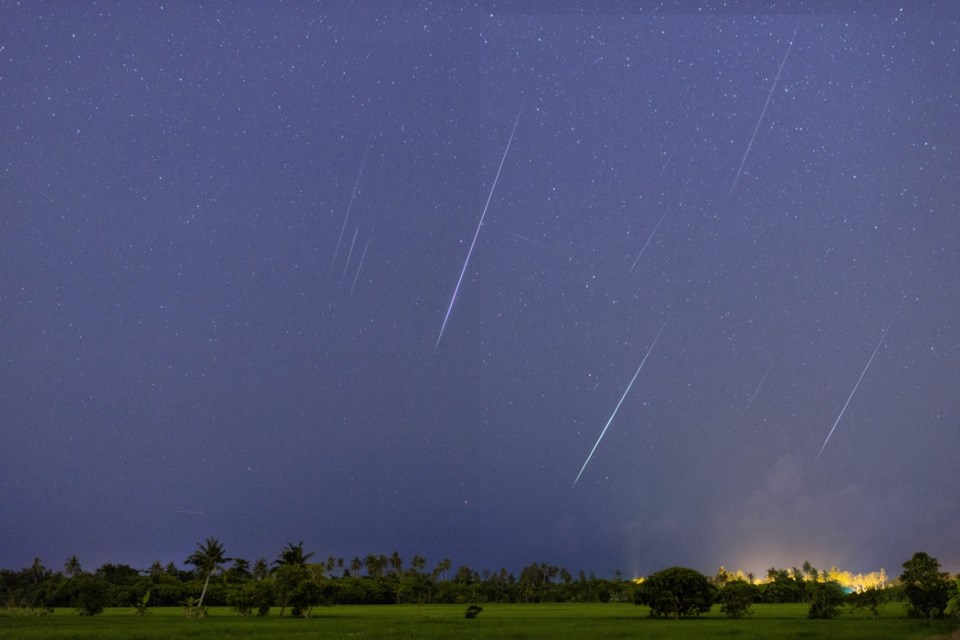The moon is full on Aug. 1, and also at perigee (357,310 kilometres) near midnight, resulting in large tides at coastal waters. Aug. 3, Saturn is two degrees north, but might be a tough observation with the bright moon so close. Aug 4 brings Neptune in close at 1.5 degrees north; you really would need a telescope to see this. Tuesday, Aug. 8, Jupiter is three degrees south of the first-quarter moon – a good photo opportunity. Uranus is three degrees southeast Aug. 8th, as well. The next day sees the moon among the Pleiades stars (M45). Aug. 13, Pollux, one of the Gemini twins, is 1.1 degrees north of the moon. New moon is Aug. 16, when it reaches apogee of 406,634 kilometres. Friday, Aug. 18 see the Minor Planet Pallas 1.1 degrees north; for viewers in Canada’s extreme north, this is an occultation, with the thin crescent moon passing in front of the tiny object. Also, Mars is two degrees south that same day. Just after first quarter Aug. 24, Antares, the bright red star in Scorpius, is occulted for viewers in the southern half of Canada and the continental United States. Coming full circle, one “moonth” later, the moon is again at perigee Aug. 30 and Saturn is again two degrees north; this is a full moon, the largest appearance in 2023.
Mercury is poorly placed for northern observers, hugging the near-horizontal ecliptic, the speedy planet sets just about the same time as the sun. It’s a great apparition for Southerners, though.
Venus is too close to the sun and too far south for northern observers during the first part of August. However, it is observable, even at inferior conjunction, as it’s 7.7 degrees south. An experienced telescopist can get a glimpse of the razor-thin crescent, even in the daytime. By month end, Venus is shining brightly in the eastern morning sky – the Morning Star.
Mars dims remarkably to become near invisible, especially as it nears the sun in evening twilight. The moon glides by on Aug. 18.
Jupiter is just south of the last-quarter moon in the early morning of Aug. 8 (Uranus is lurking close by to the east). The Pleiades and Hyades are quite prominent a few degrees east of the planets. You could try viewing the moon and Jupiter in the daytime sky, right after sunrise. They will be directly south and quite visible.
Saturn is two degrees north of the moon Aug. 1 and the 30. The Ringed Planet reaches opposition Aug. 27, visible throughout the night before and after this date.
Uranus rises shortly after midnight among the stars of Aries, the Ram. The blue planet is joined by the moon on the evening of Aug. 8. At the end of the month, Uranus appears to stand still, then begins a retrograde motion for the remainder of the year.
Neptune rises in the evening, with the moon nearby on Aug. 4. The blue-green gas planet is slowly approaching opposition on Sept. 19.
The Perseid meteors peak the night of Aug. 12. That’s when Earth passes through the cloud of tiny particles left behind by Comet 109P/Swift-Tuttle in its many passes by the sun. It has been confirmed that the earliest sighting was over 2,100 years ago, returning approximately every 130 years. It is next due to appear in 2126.
James Edgar has had an interest in the night sky all his life. He joined the Royal Astronomical Society of Canada in 2000, was national president for two terms, is now the editor of the Observer’s Handbook, and production manager of the bi-monthly RASC Journal. The IAU named asteroid 1995 XC5 “(22421) Jamesedgar” in his honour and in 2021 he was awarded a Fellowship of the RASC.



